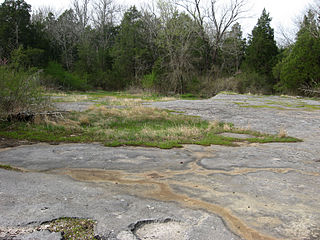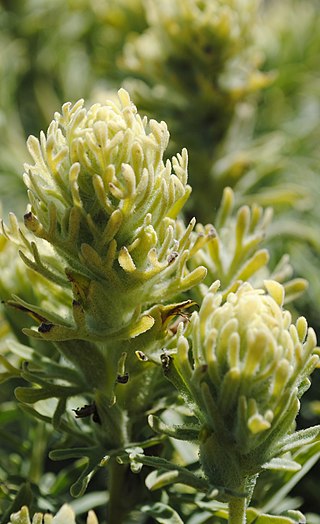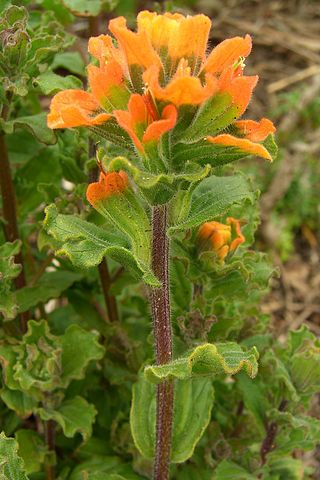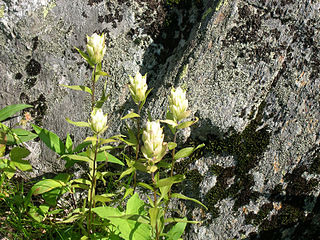
Castilleja indivisa, commonly known as Texas Indian paintbrush or entireleaf Indian paintbrush, is a hemiparasitic annual wildflower native to Texas, Louisiana, and Oklahoma in the United States. There are historical records of the species formerly growing in Arkansas, and reports of naturalized populations in Florida and Alabama.

A calcareous glade is a type of ecological community that is found in the central Eastern United States. Calcareous glades occur where bedrock such as limestone occurs near or at the surface, and have very shallow and little soil development. Due to the shallow soil and the extreme conditions created by it, trees are often unable to grow in the glades. This creates a habitat that is usually sunny, dry, and hot. Calcareous glade vegetation is more similar to that of a desert habitat than a grassland, being dominated by small spring annuals with occasional geophytic or succulent perennials.

The Tiburon paintbrush or Tiburon Indian paintbrush is an endangered taxon of flowering plant in the family Orobanchaceae. It is endemic to the San Francisco Bay Area in California in the United States, where it occurs in Marin, Napa, and Santa Clara Counties.

Castilleja angustifolia is a species of wildflower known by the common names northwestern Indian paintbrush and desert Indian paintbrush. It is an herbaceous perennial native to the desert, scrublands, and woodlands of western North America. It grows in hot sandy soils and rock crevices in dry conditions.

Castilleja linariifolia is a perennial plant, native to the United States and is the state flower of Wyoming. It has a number of common names including Wyoming Indian paintbrush, narrow-leaved Indian paintbrush, desert paintbrush, Wyoming desert paintbrush, Wyoming paintbrush, linaria-leaved Indian Paintbrush, and Indian paintbrush.

Castilleja affinis is a species of Castilleja known by the common name coast Indian paintbrush.

Castilleja campestris is a species of Indian paintbrush known by the common name vernal pool Indian paintbrush. It is native to California and southern Oregon, where it grows in seasonally moist habitat, especially vernal pools.

Castilleja grisea is a rare species of Indian paintbrush known by the common name San Clemente Island Indian paintbrush. It is endemic to San Clemente Island, one of the Channel Islands of California. San Clemente Island is owned by the US Navy so the Navy is involved in a management program to recover this species.
Castilleja lasiorhyncha is a species of Indian paintbrush is endemic to southern California known by the common name San Bernardino Mountains Indian paintbrush. Most of the plant's range is in the San Bernardino Mountains, where it grows in forests and meadows.

Castilleja latifolia is a species of Indian paintbrush known by the common name Monterey Indian paintbrush.

Castilleja miniata is a species of Indian paintbrush known by the common name giant red Indian paintbrush. It is native to western North America from Alaska to Ontario to California to New Mexico, where it grows usually in moist places in a wide variety of habitat types.
Castilleja praeterita is a species of Indian paintbrush known by the common name Salmon Creek Indian paintbrush. It is endemic to the High Sierra Nevada of California, where it grows in dry sagebrush meadows.

Castilleja levisecta is a rare species of flowering plant in the family Orobanchaceae known by the common name golden paintbrush, or golden Indian paintbrush, listed under the Endangered Species Act in 1997. It is native to British Columbia and Washington, where it is known from eleven remaining populations. It occurred in Oregon but all natural occurrences there have been extirpated. It has been reintroduced to a few areas in Oregon, but it remains to be seen if the plants will survive. The plant is a federally listed endangered species of Canada and was listed as threatened in the United States in 1997. On June 30, 2021, the plant was proposed for delisting due to recovery.

Castilleja septentrionalis is a species of Indian paintbrush known by several different common names, including pale painted cup, northern painted cup, pale Indian paintbrush, and Labrador Indian paintbrush. The scientific name "Castilleja pallida (L.) Spreng. var. septentrionalis (Lindl.) Gray" has also been used in the past to describe this species.

Spigelia gentianoides is a rare species of flowering plant in the Loganiaceae known by the common names purpleflower pinkroot and gentian pinkroot. It is native to Alabama and Florida in the United States, where a few small populations remain. It is threatened by the loss and degradation of its habitat, and is a federally listed endangered species of the United States.

Castilleja coccinea, commonly known as scarlet Indian paintbrush or scarlet painted-cup, is a biennial flowering plant in the Orobanchaceae (broomrape) family. It is usually found in prairies, rocky glades, moist and open woodlands, thickets, and along streams in central and eastern North America.
Castilleja kerryana is a species of flowering plant in the family Orobanchaceae. It is commonly known as Kerry's Indian paintbrush or Kerry’spaintbrush. It was formally described in 2013 and so far it is known only from a small population in the state of Montana, in the Northwestern United States.

Castilleja caudata, common name Port Clarence Indian paintbrush or pale Indian paintbrush, is a plant species native to Alaska, Yukon, Northwest Territories, Nunavut, and the northeastern part of Asiatic Russia. The first common name refers to Port Clarence, on the north coast of the Bering Sea just south of Nome.
Silphium perplexumJ.R.Allison is a prairie species in the Asteraceae endemic to the state of Alabama. S. perplexum is commonly known as Old Cahaba rosinweed, a reference to the Cahaba River near which all populations of this species are found.

Castilleja hispida is a species of flowering plant in the family Orobanchaceae, also known by the common name harsh paintbrush, or harsh Indian paintbrush. It is native to British Columbia, Alberta, Washington, Idaho, Montana, and Oregon.

















